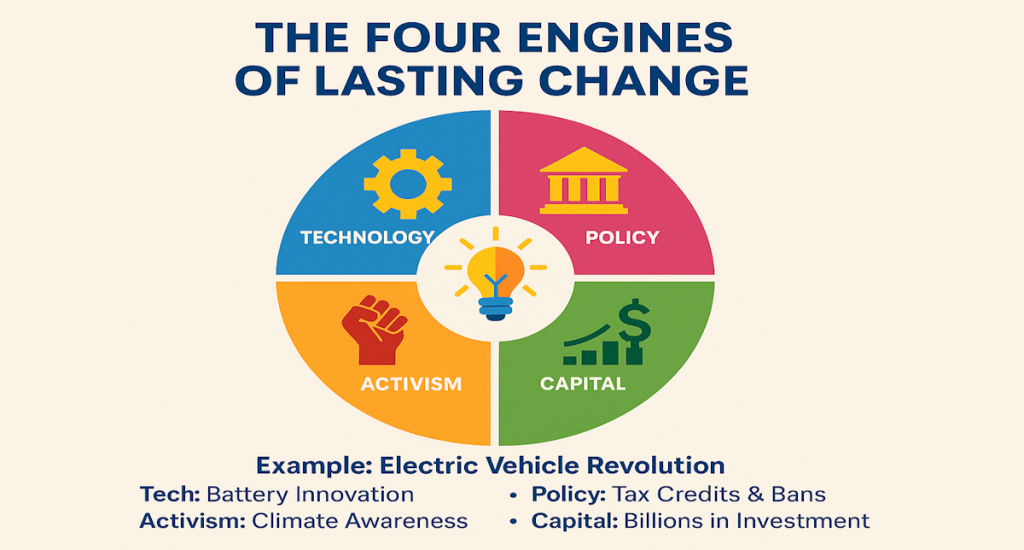The Four Engines of Change: A Framework for Understanding (And Driving) Progress

If you’re trying to make a dent in the universe—whether in your company, your industry, or society at large—it’s easy to feel overwhelmed. Where do you even begin? History provides a blueprint. Through my own reading and observation, I’ve found that meaningful, lasting change is almost always driven by the interplay of four powerful catalysts: Technology, Policy, Activism, and Capital.
None operates in a vacuum. The most transformative shifts occur when these forces align, creating a powerful synergy that reshapes our world. Let’s break them down with real-world examples.
1. Technology: The Spark of Possibility
Technology is the great enabler. It creates new tools, dissolves old barriers, and opens doors we didn’t even know existed.
- Example: The Internet (ARPANET/TCP/IP). It provided the foundational how, making global, instantaneous communication possible. But it started as a niche tool.
- Its role: To provide the means—the solution to a problem previously thought unsolvable.
2. Policy: The Framework for Scale
Technology alone isn’t enough. Policy builds the guardrails and highways that allow innovation to scale safely and equitably.
- Example: The Commercialization of the Internet (1991). The U.S. government’s policy to open the internet for commercial use created the rules of the road. This was followed by critical policies like Section 230, which shaped the modern web.
- Its role: To provide the rules—creating stability, incentives, and structures for widespread adoption.
3. Activism: The Catalyst of Conscience
Activism is the moral compass and the urgent voice. It identifies injustice, raises awareness, and creates the public demand that forces the system to respond.
- Example: The Climate Movement. For decades, activism from groups like Greenpeace and individuals like Greta Thunberg has kept relentless pressure on institutions, making climate action a global priority and creating the imperative for change.
- Its role: To provide the why—articulating the need for change and applying relentless pressure.
4. Capital: The Fuel for Execution
Ideas and imperatives need resources to become reality. Capital provides the fuel to build, scale, and sustain change.
- Example: The Renewable Energy Boom. Breakthroughs in solar tech (Technology) and government subsidies (Policy) became attractive. Venture Capital and Impact Investing then poured billions ($~300B in global investments in 2022) into companies like NextEra Energy, providing the fuel to scale manufacturing and deployment.
- Its role: To provide the resources—funding the journey from prototype to planet-wide impact.
The Magic is in the Interaction: The Electric Vehicle (EV) Case Study
Watch these four forces work together right now in the EV revolution:
- Technology: Advances in battery chemistry (lithium-ion) and software made EVs viable (Tesla).
- Activism: Growing public concern over emissions pushed automakers to find cleaner alternatives.
- Policy: Government mandates (EU combustion engine ban), tax credits (US Inflation Reduction Act), and emissions standards created a massive market incentive.
- Capital: Billions in VC funding for startups (Rivian), corporate R&D budgets (Ford, GM), and public market investment provided the capital to scale.
None of these catalysts could have done it alone.
How You Can Use This Framework
- As a Lens: Analyze any major shift—the adoption of AI, the future of work—through these four lenses. You’ll understand it on a deeper level.
- As a Strategy: If you’re leading change, ask yourself: “Which lever am I pulling? And which do I need to partner with?” A tech founder might need to engage with policymakers. An activist might need to make a business case to attract capital.
True progress isn’t a solo mission. It’s a complex dance between invention, governance, conscience, and investment. By understanding these four engines, we can stop working in silos and start building more powerful, intentional, and lasting change.
What do you think? Are there other catalysts you would add to this framework? I’d love to hear your thoughts and other examples in the comments
Tags:


